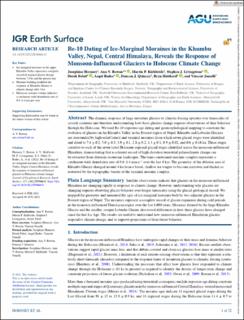| dc.contributor.author | Hornsey, Josephine | |
| dc.contributor.author | Rowan, Ann Victoria | |
| dc.contributor.author | Kirkbride, Martin P. | |
| dc.contributor.author | Livingstone, Stephen J. | |
| dc.contributor.author | Fabel, Derek | |
| dc.contributor.author | Rodes, Angel | |
| dc.contributor.author | Quincey, Duncan J. | |
| dc.contributor.author | Hubbard, Bryn | |
| dc.contributor.author | Jomelli, Vincent | |
| dc.date.accessioned | 2022-12-19T14:44:04Z | |
| dc.date.available | 2022-12-19T14:44:04Z | |
| dc.date.created | 2022-09-16T14:28:43Z | |
| dc.date.issued | 2022 | |
| dc.identifier.issn | 2169-9003 | |
| dc.identifier.uri | https://hdl.handle.net/11250/3038657 | |
| dc.description.abstract | The dynamic response of large mountain glaciers to climatic forcing operates over timescales of several centuries and therefore understanding how these glaciers change requires observations of their behavior through the Holocene. We used Be-10 exposure-age dating and geomorphological mapping to constrain the evolution of glaciers in the Khumbu Valley in the Everest region of Nepal. Khumbu and Lobuche Glaciers are surrounded by high-relief lateral and terminal moraines from which seven glacial stages were identified and dated to 7.4 ± 0.2, 5.0 ± 0.3, 3.9 ± 0.1, 2.8 ± 0.2, 1.3 ± 0.1, 0.9 ± 0.02, and 0.6 ± 0.16 ka. These stages correlate to each of the seven latest Holocene regional glacial stages identified across the monsoon-influenced Himalaya, demonstrating that a coherent record of high elevation terrestrial palaeoclimate change can be extracted from dynamic mountain landscapes. The time-constrained moraine complex represents a catchment-wide denudation rate of 0.8–1.4 mm a−1 over the last 8 kyr. The geometry of the ablation area of Khumbu Glacier changed around 4 ka from a broad, shallow ice tongue to become narrower and thicker as restricted by the topographic barrier of the terminal moraine complex. | en_US |
| dc.language.iso | eng | en_US |
| dc.publisher | AGU | en_US |
| dc.rights | Navngivelse 4.0 Internasjonal | * |
| dc.rights.uri | http://creativecommons.org/licenses/by/4.0/deed.no | * |
| dc.title | Be-10 Dating of Ice-Marginal Moraines in the Khumbu Valley, Nepal, Central Himalaya, Reveals the Response of Monsoon-Influenced Glaciers to Holocene Climate Change | en_US |
| dc.type | Journal article | en_US |
| dc.type | Peer reviewed | en_US |
| dc.description.version | publishedVersion | en_US |
| dc.rights.holder | Copyright 2022 The Author(s) | en_US |
| dc.source.articlenumber | e2022JF006645 | en_US |
| cristin.ispublished | true | |
| cristin.fulltext | original | |
| cristin.qualitycode | 2 | |
| dc.identifier.doi | 10.1029/2022JF006645 | |
| dc.identifier.cristin | 2052559 | |
| dc.source.journal | Journal of Geophysical Research (JGR): Earth Surface | en_US |
| dc.identifier.citation | Journal of Geophysical Research (JGR): Earth Surface. 2022, 127 (8), e2022JF006645. | en_US |
| dc.source.volume | 127 | en_US |
| dc.source.issue | 8 | en_US |

